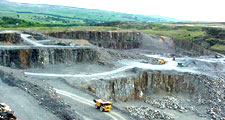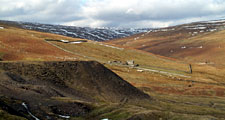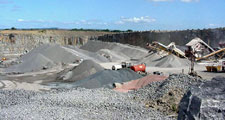Mining and Quarrying
The county is rich in minerals which have been exploited for centuries. The bole hearths of early metal workers from the Iron Age can still be found on the upland moors and survive in place names like ‘Baal Hill’. The working of minerals probably supported a dual economy of mining and farming even in this period, allowing settlement of the less fertile uplands.
The North Pennines, where mineral veins were worked for lead and other metals, and more recently fluorspar, were the world’s leading ore field in the 19th century. The legacy of lead mining remains in the prominent ‘hushes’ which scar the dale sides in places, old mine buildings, and the patterns of building clusters and isolated farms which housed the ‘miner-smallholders’ who pushed the limits of agriculture well beyond the old moor wall.
The Durham Coalfield, which covers the ridges and valleys of the west Durham Coalfield and the Wear Lowlands and extends beneath the limestone of the East Durham Plateau and out under the North Sea, was of great economic importance. Iron and steel making flourished at the interface between the coal measures and the Pennines, in places like Consett, Tow Law and Wolsingham, due to the availability of coal, limestone, and local ironstones. There are now no working collieries or steelworks. The legacy of the industry remains in the dense settlement pattern of the coalfield, the old railways and waggonways, and scattered mining remains.
Opencast coal mining has had a major impact on the landscape since 1945. Extensive areas of the exposed coal measures – around 120 square kilometres – have been opencast and restored to agriculture and forestry.
The Carboniferous and Permian limestones of the North Pennines and the East Durham Limestone Plateau have been worked since medieval times for agricultural and building limes, and more recently for refractory products and road stone. Old abandoned quarries are a feature of both landscapes, and large modern quarries continue to work the Limestone Escarpment and the Great Limestone of the dales.
Carboniferous sandstones, and to a lesser extent the Permian limestone, have provided a source of building, roofing and road stone for centuries. A number of small dimension-stone quarries can be found in the North Pennines and the Dales Fringe.
Whinstone has been quarried in Teesdale for masonry, sea defences and most recently, for road stone. Old quarries line the southern flanks of Teesdale; the columnar structure of their whinstone faces blending with the natural crags of Holwick Scar. A single active quarry remains at Forcegarth in Teesdale.
The glacial clays of the lowlands, and the brick shales and seat-earths of the coal measures have been exploited for brick making. Grey seat-earth or fireclay bricks, and rich red clay bricks are a feature of many colliery villages. There are active brickworks at Eldon and Todhills. Sands and gravels in glacial deposits and along the floodplain of the Wear have been worked for aggregates leaving scattered small sand pits and flooded gravel workings along the river.



